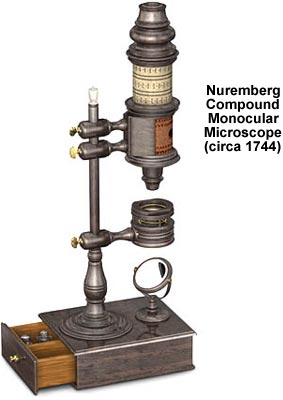Nuremberg Compound Monocular Microscope
Inscribed with the initials "J. F. F.", this compound monocular microscope was made in Nuremberg, Germany sometime after 1744. The model featured below was redrawn from photographs of the original microscope, which is part of the Billings microscope collection at Walter Reed Army Hospital in Washington DC.

The frame is constructed of dark wood and is well-fashioned, indicating that the instrument maker who fabricated this microscope was highly skilled. The base is a rectangular box with a drawer to store the two objectives and sliders that are accessories. The circular stage resembles Bonanni's design, with a spring fitting to secure the specimen. The stage is fastened to the pillar by a short arm with an adjustable jam screw. The body tube, mounted on the pillar with two similar arms, is fashioned from pasteboard and covered with dark red paper with two horizontal ornamental lines. The eyepiece, nosepiece, and other rings are made from turned wood, and focus is achieved by sliding the body tube. Inside the tube is a field lens and a bi-convex lens that act together to provide magnification of the specimen. A mirror rests on the base with a metal gimbal, and the objectives are mounted in wooden casings with metal diaphragms.
BACK TO EIGHTEENTH CENTURY MICROSCOPES
